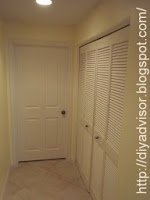 |
| Fig.2 Applied first coat |
Supplies and Tools:
Air dryer
Clean polishing rags
Sponge
Tilelab Surface Guard Penetrating Sealer (1 U.S. Gal)
We just moved into our new home and the new kitchen had brand new granite slabs for the new counter tops in the kitchen. A mild polishing agent was used before the stone arrived at my home. The additional sealer should keep it sealed for up to six months. The sealer will aid against food for example red beets. Since it sealed when the beets are cooked the liquid seems to get on everything, but I do not worry if it 's on the counter top because we purchased good quality sealer.
This shows the five steps to seal granite slabs, this job should be done every six months.
Step 1: Remove everything on the counter tops. Fig.1 shows the Tilelab Surface Guard Penetrating Sealer used to seal these counter tops.
 |
| Fig.1 Tilelab Sealer |
Step 2: Above right Fig.2 shows a clean rag on the granite counter top. Using a clean rag will aid in applying the granite sealer and removing any foggy mess from the sealer.
Step 3: Fig.3 shows the dining room side notice the cabinet lamp that was installed.
 |
| Fig.3 Applying first coat |
 |
| Fig.4 Second Coat |
 |
| Fig.5 Another coat by the sink |
 |
| Fig.6 Hair Dryer |
Update: DIY Advisor has New blogs check them today:
- Handyman Blog: DIY Advisor
- DIY Advisor Sitemap
- Food Blog: From Kiwis To Pistachios!
- Food Blog Sitemap
- Tool Blog: DIY Advisor Toolbox
- Tool Blog Sitemap
- Artwork Blog: Light in Dark Artwork
- Artwork Blog Sitemap
- Class-A Tests: DIY Class-A Drivers License Tests
- Class-A Tests Sitemap: Class-A Sitemap
- DIY Poem: DIY Poem Meter Blog
- DIY Poem Sitemap: DIY Sitemap!
- Cookie Alert: European Union laws requires that you know that this blog uses cookies. If you are concerned about this please click here to see how Google uses this information.
Note: The DIY Advisor assumes no liability for omissions, errors or the outcome of any jobs. The
reader must always exercise reasonable caution, follow current codes and regulations that may apply, and is urged to consult with a licensed contractor if in doubt about any steps on these posts. All names were changed to protect client's privacy. DIY Advisor. Reproduction of site content including photos without permission prohibited. All rights reserved.
© Copyright 2011-








































